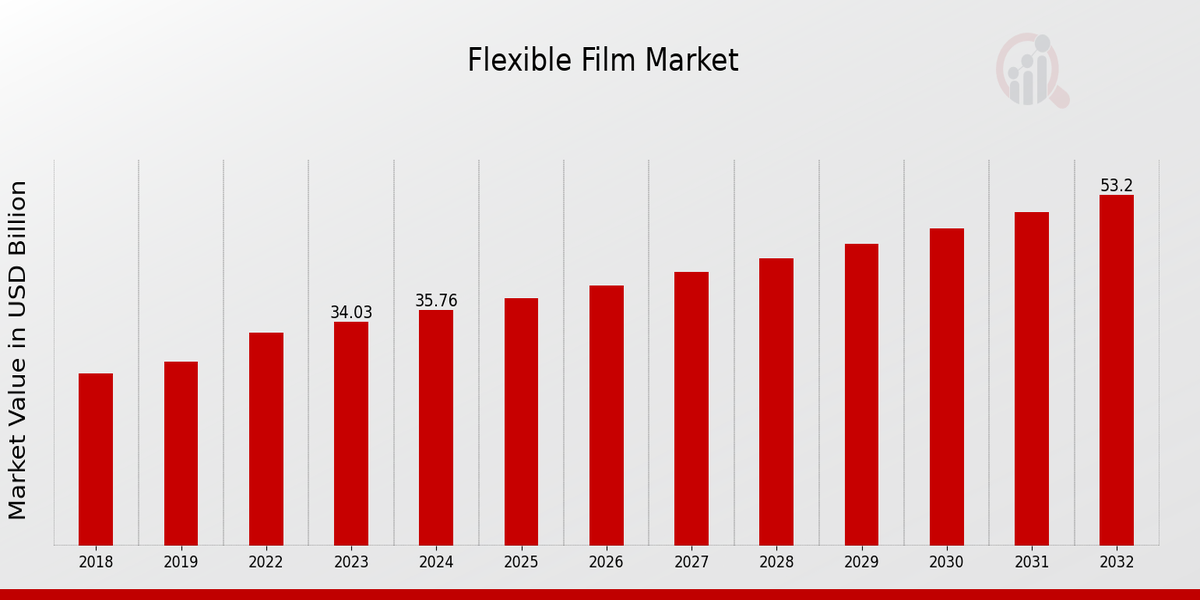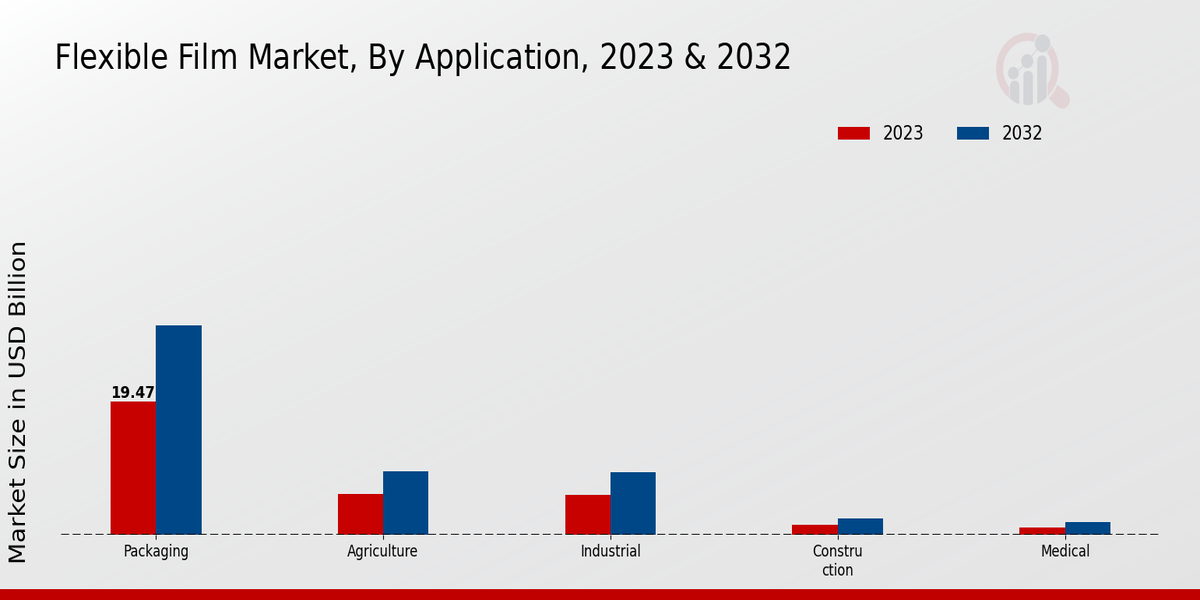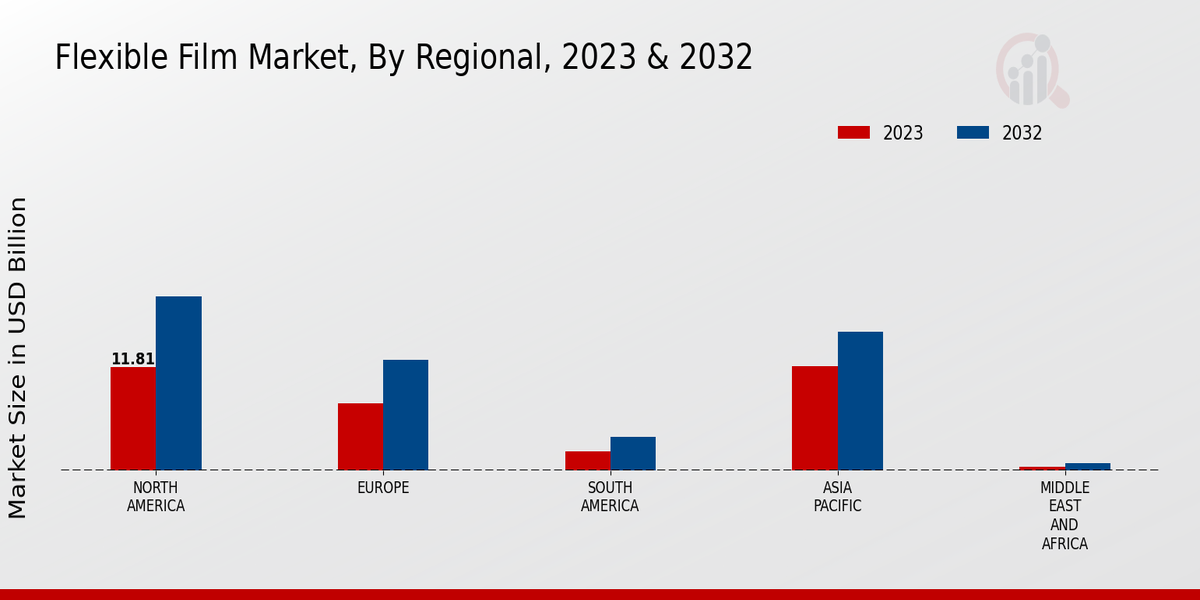Global Flexible Film Market Overview
Flexible Film Market Size was estimated at 37.58 (USD Billion) in 2024. The Flexible Film Market is expected to grow from 39.50 (USD Billion) in 2025 to 61.76 (USD Billion) by 2034. The Flexible Film Market CAGR (growth rate) is expected to be around 5.1% during the forecast period (2025 - 2034).
Source Primary Research, Secondary Research, MRFR Database and Analyst Review
Key Flexible Film Market Trends Highlighted
Growing demand for flexible packaging solutions in various industries, such as food and beverage, pharmaceuticals, and consumer products, is a major market driver. The need for lightweight, durable, and sustainable packaging options is fueling the adoption of flexible films.
The increasing penetration of e-commerce and the need for tamper-proof and convenient packaging further contribute to market growth.
Key opportunities exist in the exploration of biodegradable and compostable flexible films. The growing awareness of environmental sustainability is driving the demand for eco-friendly packaging solutions.
Additionally, advancements in printing and coating technologies enhance the aesthetic appeal and functionality of flexible films, creating opportunities for value-added products.
Recent trends include the integration of smart packaging technologies, such as RFID tags and QR codes, to enhance product tracking and consumer engagement.
The use of flexible films in smart labels and medical devices is also emerging as a potential growth area.
Furthermore, the development of high-barrier flexible films with improved gas and moisture resistance is addressing the challenges of preserving food freshness and extending shelf life in the food industry.
Flexible Film Market Drivers
Increasing Demand for Flexible Packaging
The major growth driver of the Flexible Film Market is the rising demand for flexible packaging. Flexible packaging or films offer various benefits over traditional rigid packaging. Some of the benefits include cost-effectiveness, lightweight, durability and flexibility.
As flexible packaging can mould into or take the shape of the product it can be used for purposes leading to is in adoption in wide range of applications.
Further, the need for flexible packaging has increased in industries such as food and beverage, pharmaceuticals, personal care, and consumer electronics and growth within these industries will drive the demand for flexible packaging.
While these materials are also easier to handle and use, they are favored by customers as well.
Technological Advancements and Innovation
Furthermore, the development and innovation in technology is a vital driver for the Flexible Film Market. Researchers are continuously making efforts in making flexible film more performable and functional.
The development and use of new materials, such as bio-based and biodegradable polymers, make flexible packaging sustainable and safe for the environment.
Moreover, the use of smart technology such as printed electronics and sensors develops additional values in flexible films such as product authentication, anti-counterfeiting attributes, and more consumer interaction that also thrive the market growth in varied end-use industries and among consumers.
Growing E-commerce and Online Retail
The rapid growth of e-commerce and online retail is positively impacting the Flexible Film Market. The increasing preference for online shopping has led to a surge in demand for flexible packaging solutions for product protection during shipping and delivery.
Flexible films offer lightweight and protective packaging options that are well-suited for e-commerce deliveries. Moreover, the need for tamper-evident and secure packaging to prevent product damage or tampering during transit is driving the adoption of flexible packaging in the e-commerce sector.
As online retail continues to expand, the demand for flexible films is expected to remain strong, contributing to the overall market growth.
Flexible Film Market Segment Insights
Flexible Film Market Application Insights
The Flexible Film Market is segmented by application into 5 major categories including Packaging, Agriculture, Industrial, Construction, and Medical.
In 2023, the Packaging segment was holding the largest market share of over 60% in the Flexible Film Market. The outburst of the Packaging segment can be attributed to the rising demand of Flexible Packaging solution in food beverage, pharmaceutical, and consumer goods industries.
Additionally, the Agriculture segment is estimated to expand at the highest growth rates over the forecast period owing to meeting demand for flexible film for crop protection, greenhouse cover, and mulching.
The Industrial segment is also expected to expand at a notable CAGR over the forecast years. The growth in the market for the Industrial segment can be accounted for by the increasing use of flexible film as a protective layer in a range of industrial equipment in electronics, automotive, and construction industries.
The Construction segment is expected to expand at moderate rates over the forecast period owing to the rising use of flexible film in roofing, flooring, and other construction applications.
The Medical segment is anticipated to grow at steady growth rates equated to the segments mentioned above. The rise in demand for film packaging solutions in the medical sector accounts for growth in this segment.
Source Primary Research, Secondary Research, MRFR Database and Analyst Review
Flexible Film Market Material Type Insights
The material type segment of the Flexible Film Market includes Polyethylene, Polypropylene, Polyethylene Terephthalate, Polyvinyl Chloride, and Ethylene Vinyl Acetate.
Among these materials, Polyethylene dominated the market, holding approximately 42.5 % of the Flexible Film Market revenue in 2023. PE is the most flexible, inexpensive material and is recyclable, which drives its applications in various industries, including packaging, agriculture, and construction.
Another widely used material, Polypropylene, held around 27.6% of the market share in the past year. PP-based flexible films are the strongest and clearest, and are resistant to chemicals, which makes them suitable for food containers, bags, and wraps applications, among others.
PET is anticipated to grow substantially in the next five to six years thanks to its excellent properties, including, but not limited to, outstanding moisture barrier, transparency to ultraviolet light, and recyclability.
The volume of PET use will increase dramatically in the packaging industry for food, beverages, and pharmaceuticals. PVC and EVA are also vital materials in the Flexible Film Market, and each of them has specific properties and applications.
Flexible Film Market Product Type Insights
The Flexible Film Market is segmented by Product Type into Shrink Wrap, Stretch Wrap, Laminated Film, Coated Film, and Metallized Film. The Laminated Film segment is expected to hold the largest market share in 2024, with a market value of USD 12.43 billion.
The growth of this segment can be attributed to the increasing demand for flexible packaging solutions in the food and beverage industry, which is expected to reach USD 385.15 billion by 2024.
The Coated Film segment is expected to experience the highest growth rate during the forecast period, with a CAGR of 6.2%.
The growth of this segment can be attributed to the rising demand for coated films in the automotive and electronics industries.
Flexible Film Market End-Use Industry Insights
The Flexible Film Market is segmented into various end-use industries, including Food and Beverage, Retail and Consumer Goods, Healthcare, Automotive, and Electronics.
Among these segments, the Food and Beverage industry holds a significant market share due to the extensive use of flexible films in packaging applications.
The demand for flexible films in this segment is driven by the need to preserve the freshness and quality of food and beverages while extending their shelf life.
Additionally, the growing trend of on-the-go consumption and convenience packaging is further fueling the growth of the flexible film market in the Food and Beverage industry.
The Retail and Consumer Goods segment is another major contributor to the Flexible Film Market revenue, with flexible films being widely used in packaging products such as toys, electronics, and household items.
The Healthcare industry also utilizes flexible films for medical packaging, such as IV bags, wound dressings, and sterilization pouches.
The Automotive industry employs flexible films in interior components, wire and cable insulation, and exterior body parts. Finally, the Electronics industry uses flexible films in flexible displays, printed circuit boards, and other electronic components.
Flexible Film Market Substrate Insights
The Flexible Film Market is segmented by Substrate into Paperboard, Metal, Glass, Plastic, and Textile. Plastic held the largest market share in 2023, accounting for over 60% of the Flexible Film Market revenue.
The growth of the plastic segment can be attributed to the increasing demand for flexible packaging solutions in the food and beverage industry. Paperboard is another major substrate used in the production of flexible films, and it is expected to witness a steady growth rate during the forecast period.
Metal and glass substrates are used in specialized applications, such as food packaging and pharmaceutical packaging, and they are expected to grow at a moderate pace.
Textile substrates are used in the production of flexible films for clothing and other applications, and they are expected to show a slow but steady growth rate.
Flexible Film Market Regional Insights
Regionally, the market is segmented into North America, Europe, APAC, South America, and MEA. North America held the largest market share in 2023, accounting for approximately 36% of the revenue.
The region's growth is attributed to the presence of a well-established packaging industry, particularly in the food and beverage sector.
Europe is the second-largest market, with a market share of around 28% in 2023. The region's growth is driven by increasing demand for sustainable packaging solutions and stringent regulations regarding plastic waste management.
APAC is the fastest-growing region in the Flexible Film Market, with a projected CAGR of 6.2% during the forecast period. The growth is primarily driven by the rapidly expanding food and beverage industry in countries such as China and India.
South America and MEA are expected to witness steady growth in the coming years, with increasing demand for flexible packaging in various end-use industries.

Source Primary Research, Secondary Research, MRFR Database and Analyst Review
Flexible Film Market Key Players and Competitive Insights
Major players in the Flexible Film Market are constantly striving for Flexible Film Market development, with research and development activities taking center stage.
The Flexible Film Market competitive landscape is highly dynamic, with leading Flexible Film Market players adopting various strategies to gain a competitive edge. Some of the key strategies include product innovation, mergers and acquisitions, and strategic partnerships.
Amcor plc is a leader in the Flexible Film Market, offering a wide range of flexible packaging solutions. The company has a strong focus on sustainability and innovation, and is committed to providing its customers with high-quality, cost-effective packaging solutions.
Amcor plc has a presence, with operations in over 40 countries. The company's diverse product portfolio includes flexible packaging for food, beverage, pharmaceutical, and personal care products.
Amcor plc is known for its strong commitment to customer service and its ability to meet the unique needs of each customer. The company's reach and extensive product portfolio make it a formidable player in the Flexible Film Market.
Berry Inc. is another leading player in the Flexible Film Market. The company is known for its innovative and high-performance packaging solutions. Berry Inc. has a strong focus on research and development and is committed to providing its customers with cutting-edge packaging solutions.
The company's product portfolio includes a wide range of flexible packaging solutions, including films, laminates, and pouches. Berry Inc. has a presence, with operations in over 50 countries.
The company's strong focus on innovation and its reach makes it a major player in the Flexible Film Market.
Key Companies in the Flexible Film Market Include
- Dow
- Amcor
- Jindal Films
- ITC
- Wipak
- ExxonMobil
- SABIC
- Berry Global
- Uflex
- Sealed Air
- Wihuri Group
- LyondellBasell
- Plastic Suppliers
- Braskem
Flexible Film Market Developments
Recent market developments in the Flexible Film Market indicate a steady growth trajectory. The market growth is primarily driven by the increasing demand for flexible packaging solutions in the food, beverage, and pharmaceutical industries.
Additionally, advancements in technology and material science, such as the development of biodegradable and sustainable films, are expected to further drive market expansion.
Strategic partnerships and acquisitions, such as Amcor's acquisition of Bemis Company in 2019, are shaping the industry landscape and consolidating market share.
The growing adoption of e-commerce and the need for lightweight and durable packaging are also contributing to the positive outlook for the Flexible Film Market.
Flexible Film Market Segmentation Insights
- Flexible Film Market Application Outlook
- Packaging
- Agriculture
- Industrial
- Construction
- Medical
- Flexible Film Market Material Type Outlook
- Polyethylene (PE)
- Polypropylene (PP)
- Polyethylene Terephthalate (PET)
- Polyvinyl Chloride (PVC)
- Ethylene Vinyl Acetate (EVA)
- Flexible Film Market Product Type Outlook
- Shrink Wrap
- Stretch Wrap
- Laminated Film
- Coated Film
- Metallized Film
- Flexible Film Market End-Use Industry Outlook
- Food and Beverage
- Retail and Consumer Goods
- Healthcare
- Automotive
- Electronics
- Flexible Film Market Substrate Outlook
- Paperboard
- Metal
- Glass
- Plastic
- Textile
- Flexible Film Market Regional Outlook
- North America
- Europe
- South America
- Asia Pacific
- Middle East and Africa
Flexible Film Market Report Scope
| Report Attribute/Metric |
Details |
| Market Size 2024 |
37.58 (USD Billion) |
| Market Size 2025 |
39.50 (USD Billion) |
| Market Size 2034 |
61.76 (USD Billion) |
| Compound Annual Growth Rate (CAGR) |
5.1% (2025 - 2034) |
| Report Coverage |
Revenue Forecast, Competitive Landscape, Growth Factors, and Trends |
| Base Year |
2024 |
| Market Forecast Period |
2025 - 2034 |
| Historical Data |
2020 - 2024 |
| Market Forecast Units |
USD Billion |
| Key Companies Profiled |
Dow, Amcor, Jindal Films, ITC, Wipak, ExxonMobil, SABIC, Berry Global, Uflex, Sealed Air, Wihuri Group, LyondellBasell, Plastic Suppliers, Braskem |
| Segments Covered |
Application, Material Type, Product Type, End-Use Industry, Substrate, Regional |
| Key Market Opportunities |
Growing demand for flexible packaging Increasing use of flexible films in electronics Rising adoption in healthcare and pharmaceuticals Expanding e-commerce sector Innovations in sustainable and biodegradable films |
| Key Market Dynamics |
Growing demand for flexible packaging Technological advancements Increasing consumer preference for sustainable packaging Rising e-commerce industry Expansion into emerging markets |
| Countries Covered |
North America, Europe, APAC, South America, MEA |
Frequently Asked Questions (FAQ) :
The flexible film market size is expected to reach USD 61.76 billion by 2034, exhibiting a CAGR of 5.1% during the forecast period. The market growth can be attributed to increasing demand from various end-use industries, such as food, beverage, and healthcare.
Asia Pacific is anticipated to dominate the flexible film market throughout the forecast period. The region's growth is driven by factors such as rising population, increasing disposable income, and rapid urbanization, leading to a surge in demand for packaged food and beverages.
The increasing demand for flexible packaging solutions due to their lightweight, durability, and cost-effectiveness is a primary growth driver for the flexible film market. Additionally, the growing adoption of flexible films in emerging markets, coupled with technological advancements and product innovations, is further bolstering market expansion.
The food packaging segment is estimated to hold the largest share of the flexible film market. The increasing demand for flexible packaging in the food industry, driven by factors such as convenience, shelf-life extension, and product differentiation, is contributing to the segment's growth.
Some of the prominent players operating in the flexible film market include Amcor plc, Sealed Air Corporation, Dow Inc., Berry Group, Inc., and Treofan Group. These companies are focusing on expanding their production capacities, investing in research and development, and forming strategic partnerships to maintain their competitive edge.
Fluctuating raw material prices, stringent environmental regulations, and intense competition from alternative packaging materials pose challenges to the growth of the flexible film market. Additionally, concerns regarding plastic waste and sustainability are driving the need for eco-friendly and biodegradable film solutions.
The adoption of sustainable and biodegradable materials, such as plant-based plastics and compostable films, is gaining traction in the flexible film market. Furthermore, advancements in printing and converting technologies are enabling the production of high-quality, customized, flexible films to meet specific customer requirements.
The COVID-19 pandemic had a moderate impact on the flexible film market. While demand from certain end-use industries, such as food and healthcare, remained strong, other sectors, such as automotive and non-essential consumer goods, experienced a decline in demand. However, the market is expected to recover and resume its growth trajectory in the post-pandemic period.
Growing demand from emerging economies, rising e-commerce penetration, and increasing adoption of flexible films in non-traditional applications, such as electronics and medical devices, present significant growth opportunities for the flexible film market.
Investors should consider factors such as regional market dynamics, competitive landscape, technological advancements, environmental regulations, and sustainability trends when evaluating investment opportunities in the flexible film market. Additionally, assessing the financial performance, production capabilities, and innovation strategies of potential partners is crucial for successful investments.

















